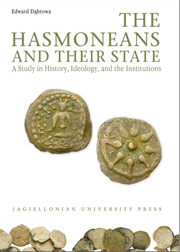Book contents
- Frontmatter
- Contents
- Introduction
- Abbreviations
- Part I Judea under the Hasmoneans (167–63 BCE)
- 1 Mattathias and Judah: In Defense of the Ancestors' Religion
- 2 Jonathan and Simon: A Strategy for Independence
- 3 John Hyrcanus: Securing Independence and the Rise of Expansionist Policy
- 4 Hasmonean Kings
- Part II The Institutions of the Hasmonean State
- Part III Society
- Conclusions
- Bibliography
- Index of Personal Names
- Index of Place Names
- Index of Ancient Sources
- Electrum - Volumes Published
- The Hasmonean State
3 - John Hyrcanus: Securing Independence and the Rise of Expansionist Policy
from Part I - Judea under the Hasmoneans (167–63 BCE)
Published online by Cambridge University Press: 05 September 2014
- Frontmatter
- Contents
- Introduction
- Abbreviations
- Part I Judea under the Hasmoneans (167–63 BCE)
- 1 Mattathias and Judah: In Defense of the Ancestors' Religion
- 2 Jonathan and Simon: A Strategy for Independence
- 3 John Hyrcanus: Securing Independence and the Rise of Expansionist Policy
- 4 Hasmonean Kings
- Part II The Institutions of the Hasmonean State
- Part III Society
- Conclusions
- Bibliography
- Index of Personal Names
- Index of Place Names
- Index of Ancient Sources
- Electrum - Volumes Published
- The Hasmonean State
Summary
Simon's work to build his state's structures was violently interrupted by his death in an assassination instigated by his son-in-law Ptolemy, the son of Abubus. The latter had formed a conspiracy to murder all members of the Hasmonean family and take over rule of Judea (cf. 1 Macc 16:13–20). His will to power was so great that he went so far as to ask the Syrian king for help and was even willing to become his vassal (1 Macc 16:13.18). The plan failed because John, the son of Simon, then at Gezer, was warned of the danger and took steps to stop Ptolemy. The first, decisive step was to take control of the capital. With Jerusalem in his hands, John could officially claim the role of high priest and political leader after his father. Although such power landed in his lap quite unexpectedly, he was nonetheless quite well prepared to exercise it. He owed his knowledge of managing people and making decisions to his father, who had in due time entrusted to him command of the army (1 Macc 13:53). He had gained valuable experience in victorious campaign against a Syrian army under Cendebeus (1 Macc 16:2–3). It is not known whether Ptolemy's attempt met with any wider response in Judea's society. His imminent defeat and flight from the country seem to corroborate John's considerable popularity and the support he enjoyed among his subjects. Nonetheless, Ptolemy's plot must be seen as a clear sign of tensions existing in the ruling elites.
- Type
- Chapter
- Information
- The Hasmoneans and their StateA Study in History, Ideology, and the Institutions, pp. 67 - 83Publisher: Jagiellonian University PressPrint publication year: 2009



